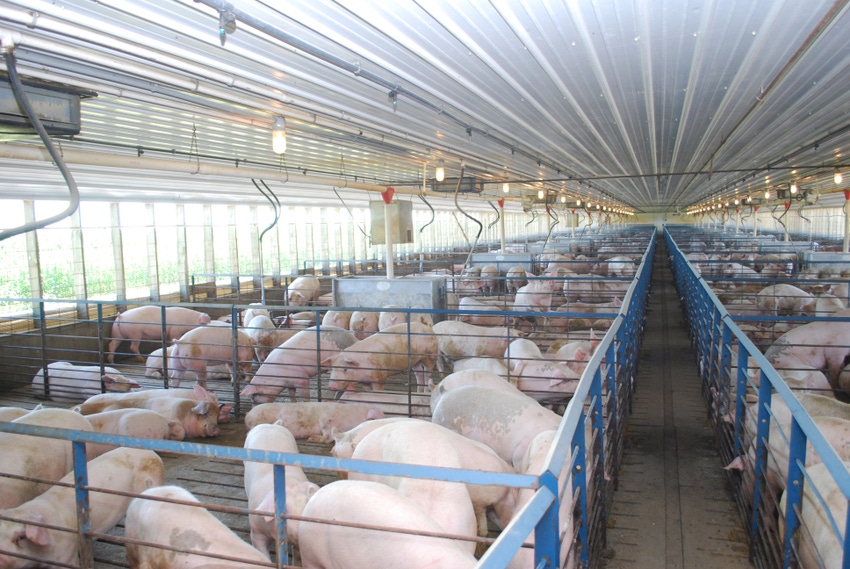The average pigs saved per litter was 11.19 for the September-November period, compared to 11.05 last year.

According to the latest USDA Quarterly Hogs and Pigs report, the U.S. inventory of all hogs and pigs on Dec. 1, 2021 was 74.201 million head, down 4% from the year prior, and 1% from last quarter. Analysts expected that number to be down about 2.8%.
Breeding inventory, at 6.18 million head, was up slightly from last year, but down slightly from the previous quarter.
Market hog inventory, at 68.021 million head, was down 4.4% from last year, and down 1% from last quarter. Pre-report estimates had that figure down 2.9%.
For the under-50-pounds weight category, there were 21.174 million head, down 3.7% from last year. Trade had thought that number would be down 2.9%. In the 50-to-119 pounds group, there were 19.185 million head, down 2.5% and very close to what analysts expected.
There were some significant differences in the heavyweight categories from pre-report expectations, with 14.809 million head in the 120-to-179-pounds group. That weight category is down 6.2%; analysts thought that would be down 3.8%. Finally, for the 180-and-over group there were 12.853 million head, down 6%. Analysts had thought that number would be down 3%.
"If you look at actual slaughter, total daily slaughter on the equal number of weekdays and Saturdays this year versus a year ago, that number was down 5.4%, so not too far off from where the 180-and-over was," says Steve Meyer, Partners for Production Agriculture.
The September-November 2021 pig crop, at 33.712 million head, was down 4% from 2020. That's 3.6% lower than a year ago, and analysts had thought that number would be down about 2.7%. Sows farrowing during this period totaled 3.012 million head, down 4.8% from 2020. Analysts had thought that number would be down 3.1%. The sows farrowed during this quarter represented 49% of the breeding herd.
U.S. hog producers intend to have 2.943 million sows farrow during the December 2021-February 2022 quarter, up slightly from the actual farrowings during the same period one year earlier, but down 8% from the same period two years earlier. Intended farrowings for March-May 2022, at 3.01 million sows, are down 1% from the same period one year earlier, and down 4% from the same period two years earlier.
The average pigs saved per litter was 11.19 for the September-November period, compared to 11.05 last year.
The total number of hogs under contract owned by operations with over 5,000 head, but raised by contractees, accounted for 47% of the total U.S. hog inventory, down 1% from the previous year.
Independent market analyst Bob Brown noted the USDA revisions to prior data in the December report. The Dec. 1, 2019 inventory was revised downward to 1.4 million head. The March 1, 2020 inventory was revised, down a million head. The June 1, 2021 report was revised down at 1.25 million.
"As we all know, 2020 was not a normal year by any stretch, especially April, June of 2020, when we had a lot of downtime in the slaughter plants, which messed up trying to compare pig crops and slaughter," Brown says. "They're just doing their best to try to keep this data true up to what we had and with recent slaughter down about 5%, that's kind of the latest litmus test that we have to work on."
Extension economist emeritus at the University of Missouri, Ron Plain says in his estimation, this is a positive pig report and one of the reasons is market hog inventory is smaller, not only smaller than a year ago, but smaller than trade expectations.
"USDA said market hog numbers were down 4.4%, on the first day of December. Basically, this is hog slaughter for the next six months. December through June should be pretty well alive and on farms this time, so down 4.4% in market hog numbers; that is also 1.5% smaller than the trade was expecting," Plain says. "Not a whole lot of hogs out there, and with respect to what it means for prices, when you have fewer hogs than the trade was guessing, it's a good chance we may see some upward movement in lean hog futures when they open next."
David Miller, chief economist for Decision Innovation Solution, says most surprising part of the December 2021 inventory report was the Iowa breeding herd.
"The breeding herd came in at 100% of a year ago, but if we dig down a little deeper that's 97% in Iowa and Iowa was 97% a year ago, so that's two years in a row the December breeding herd in Iowa has been down," Miller says.
"I probably expected it to be more in line with Illinois, Indiana, Nebraska, all that showed positive growth on the breeding herd compared to a year ago," Miller says.
About the Author(s)
You May Also Like





